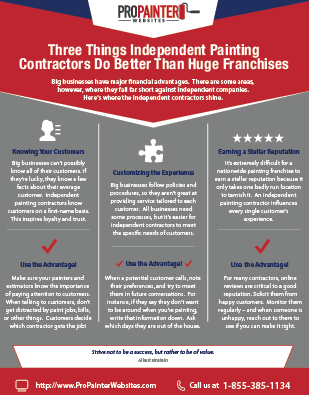Seasonal Considerations For Business Exterior Painting: What You Need To Know
Seasonal Considerations For Business Exterior Painting: What You Need To Know
Blog Article
Web Content Create By-Aguilar Browne
When you're preparing a commercial exterior painting task, seasonal aspects can make or break your outcomes. You'll intend to consider just how temperature level and humidity effect paint application and drying times. Choosing the appropriate season can guarantee your paint adheres properly and lasts much longer. However which seasons are truly the best for this type of job? Allow's check out the key elements that can influence your job's success.
The Effect of Temperature on Paint Application
When you're planning a commercial exterior paint task, the temperature can significantly affect how well the paint adheres and dries.
Ideally, you intend to paint when temperature levels vary in between 50 ° F and 85 ° F. If it's too chilly, the paint may not cure properly, resulting in concerns like peeling off or fracturing.
On Web Site , if it's also warm, the paint can dry out too swiftly, avoiding correct bond and causing an irregular coating.
You need to also think about the time of day; early morning or late afternoon supplies cooler temperatures, which can be much more desirable.
Always examine the producer's referrals for the details paint you're using, as they often provide guidance on the ideal temperature level range for optimum outcomes.
Humidity and Its Impact on Drying Times
Temperature isn't the only ecological variable that influences your commercial external painting project; moisture plays a significant role as well. High moisture degrees can reduce drying out times considerably, impacting the general quality of your paint job.
When the air is filled with dampness, the paint takes longer to heal, which can bring about issues like poor attachment and a greater threat of mildew growth. If you're repainting on a particularly moist day, be prepared for prolonged wait times between coats.
It's vital to monitor regional weather conditions and strategy accordingly. Preferably, aim for humidity degrees between 40% and 70% for ideal drying.
Maintaining these factors in mind ensures your task stays on track and delivers a long-term surface.
Best Seasons for Commercial Exterior Paint Projects
What's the most effective season for your business outside paint tasks?
over at this website and very early fall are usually your best options. Throughout these seasons, temperatures are light, and humidity degrees are frequently reduced, developing optimal problems for paint application and drying.
Stay clear of summertime's intense heat, which can create paint to dry also promptly, resulting in inadequate bond and finish. Similarly, winter's chilly temperature levels can prevent proper drying and treating, risking the durability of your paint work.
Go for custom painting companies with temperature levels between 50 ° F and 85 ° F for optimal outcomes. Bear in mind to inspect the neighborhood weather report for rainfall, as damp problems can ruin your job.
Planning around these aspects guarantees your painting task runs smoothly and lasts much longer.
Verdict
In conclusion, preparing your industrial external paint jobs around seasonal considerations can make a considerable difference in the outcome. By visit the next post during the optimal temperatures and moisture degrees, you'll make sure far better bond and drying times. Bear in mind to keep an eye on neighborhood weather report and select the correct time of year-- spring and early fall are your best options. Taking these actions will certainly aid you achieve a sturdy and specialist surface that lasts.
